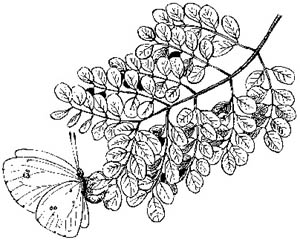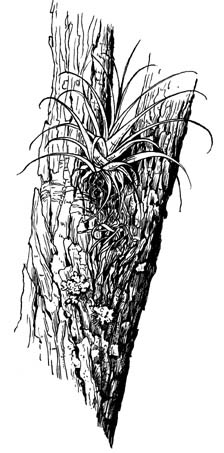Lysiloma sabicu
By Arlene Ferris, Director of Volunteer Services
Drawings by Elizabeth Smith
These are a few of our favorite plants . . .
 |
| butterfly laying eggs |
It would be hard for any person who loves plants to pick just one as their favorite, but for a person who lives in South Florida – and works in a botanical garden – it's even harder! One is literally surrounded by potential favorites. Who could bypass the royal poinciana, the golden shower tree or the Cassia javanica in summer? Who could ignore the splendid blossoms of the jade vine, the night-blooming cereus or the shaving brush tree, or overlook the orchids and water lilies that have to be counted among the most gorgeous of nature's creations? For that matter, ‘I've always had a special place in my heart for gardenias since I moved to South Florida many years ago and bought one immediately, proudly signaling my arrival in the subtropics.
 |
| rough-textured bark with lichens and epiphytes |
But my favorite plant right now isn't known for its spectacular flowers or stunning foliage. It's a tree that I love because it grows right outside of my dining room window and I get to watch it daily, in all its manifestations, and to enjoy the many butterflies and birds which are attracted to it. This tree is a little beauty named Lysiloma sabicu.
There are about 33 species in the genus Lysiloma, which is found throughout the tropical and subtropical Americas. Lysiloma sabicu grows to be about 25' tall and has a spreading crown. It is known as an excellent shade tree, and was recommended by Nixon Smiley as a good hurricane tree. Years ago it was one of the most valuable timber trees in Cuba, and considerable quantities were shipped to the United States and England for furniture, shipbuilding and interior trim. Commercial size trees are found only sparingly now.
Lysiloma sabicu sheds its leaves briefly in the late winter but the flush of new leaves happens quickly, and the small, bipinnate leaves are a reddish-brown color when they first emerge. Throughout much of the year it attracts butterflies, and my tree is visited almost daily by sulfur butterflies who spend their days flitting between it, a Senna polyphylla and a bed of blue porterweed planted nearby. Rare is the day when there aren't butterfly performances running continuously in the front yard. The light gray, shaggy bark of the Lysiloma sabicu provides a perfect habitat for epiphytes and lichens, and there are several species of native tillandsias growing on the trunk of mine.
 |
| Spent chrysalis on Tillandsia leaf |
Another reason this tree is my favorite is that this spring I counted five different kinds of birds feeding in it, and on several occasions they were all feeding at once! The cardinal, oriole, blue jay, grackle and woodpecker were snapping up little green caterpillars left and right. It's hard not to love a tree that supplies you with such an engaging bird-watching opportunity. The flowers of Lysiloma sabicu are small, fragrant yellow puffballs, and it blooms intermittently during the warmer months of the year. The tree architecture is lovely, and with a little trimming in the right places the branching pattern is intricate and symmetrical. This tree is definitely at the top of my most favorite list and I hope, if you plant it in your garden, it will soon be at the top of yours.
Garden News, September 1998